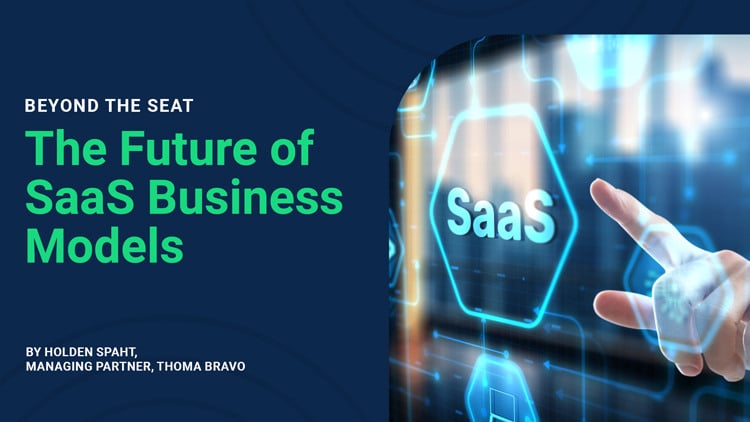
As I talk with CEOs across the SaaS industry, a common theme emerges: the traditional seat-based pricing model is under increasing pressure. The rapid advancement of AI, changing customer expectations, and the need for more value-aligned pricing are pushing companies to reconsider how they monetize their software. These conversations reveal a growing recognition that the "seat" — long a convenient abstraction for pricing — is becoming less reflective of software’s value and less sensible as a business model. "In three years, I doubt we'll still be pricing on a per-seat basis," a CEO of one of Thoma Bravo’s portfolio companies recently told me.
This shift isn't just about adapting to new technologies. It's about rethinking the relationship between software providers and their customers to better reflect software’s tangible business outcomes. The challenge lies in quantifying and agreeing on that value — a task that requires a deep understanding of the connection between the software's capabilities and the customer's business needs. And while agreement on an objective measure of software-induced productivity may not be in sight, stagnation isn’t a solution.
It's a tricky problem — and its complexity helps explain why the seat has been so sticky. Contrasted with the daunting task of finding an alternative pricing model, pricing-by-seat can feel refreshingly simple, both to understand and to implement. But that same simplicity also masks immensely valuable metrics that would help quantify precisely where and how software boosts productivity — and that information would help both sides of the transaction.
The dilemma — between inertia to stay with what’s easiest and transitioning toward what’s most effective — is getting sharper. Enterprises are experiencing subscription fatigue, mirroring consumers' frustration with managing multiple subscriptions. Much of the ROI in enterprise software comes from “doing more with less” — which often means seat reduction over time. Some customers — particularly in a soft economy — scrutinize seat counts and pressure vendors to down-sell at renewal. As SaaS vendors try to compensate for fewer seats, they’ve been raising seat prices (the average spend on SaaS per employee jumped 17.9% from 2022 to 2023). And the meteoric rise of generative AI is accelerating these trends, as customers are being told they can accomplish more with each “seat” than was previously possible.
These pressures widen the gap between what seat-based pricing can capture and the real value software delivers. When faced with a chasm, markets build a bridge. Look no further than any number of pricing model experiments that have emerged of late:
- In the infrastructure space, companies like Twilio and Snowflake are finding success with usage-based pricing.
- Encompass by ICE Mortgage Technology — the flagship product of our former portfolio company Ellie Mae which was sold to ICE — is priced based on the number of loans originated on its system by customers, directly tying the cost of the software to a key value metric for their clients (the volume of business processed through the platform).
- Another former portfolio company, iPipeline (acquired by Roper Technologies, Inc. ) — whose software generates life insurance applications for major carriers — bases its pricing on the number of applications generated, using a banded approach. This model recognizes that the value of the software scales with usage but also provides customers with pricing and budget predictability.
- And in the marketing automation space, some companies price based on the number of customer records in the CRM system. This approach ties pricing to a proxy for both utilization and the marginal costs associated with serving larger clients, reflecting the increased value and resource consumption as a customer's database grows.
What started as small experiments in alternative pricing models is evolving into a broader conversation about how both buyers and sellers can find alternatives that better align value, cost, and pricing. These early examples give us a glimpse into potential future directions of SaaS pricing — and show that it's indeed possible to move away from seat-based models towards pricing structures that more closely align with value delivered to customers. We can expect to see a variety of such experiments over the next few years. I believe that experimentation represents an important type of market innovation that sits next to — and can be equally important to — pure technology innovation.
As the market innovates "beyond the seat," several key considerations will emerge for SaaS companies looking to advance their pricing models — chief among them is the challenge of quantifying and agreeing with customers on value. Start by assuming that both customers and software vendors agree in principle that software should be sold based on the value it provides to the business it serves. In theory, if both parties can agree on a business case and ROI, the price would naturally follow. It makes good sense, for example, to consider ratios that share the value between parties — suggesting, for example, that if the annual P&L benefit for a customer is $100 million, they might reasonably pay $25 million per annum for the software.
The way it plays out in reality isn’t so simple. Incentives can be misaligned — salespeople often focus on short-term targets rather than long-term value creation, while customers are tempted to save money by downplaying the benefits. You don’t have to assume bad-faith negotiations here; it’s a combination of structural information asymmetry (customers know more about the business than the salesperson) and true uncertainty about what’s ahead.
This is where data-driven decision-making might fix part of the problem. SaaS companies are sitting on enormous datasets rich with information about how their customers use and derive value from their products; by analyzing this data, software providers can start to construct metrics that more closely correlate with value creation for their customers. Another portfolio company CEO recently told me, "We can see how much we're saving our customers in real- time." That's precisely the kind of insight that is invaluable in developing pricing models that truly reflect the value delivered.
The transition to new pricing models will also require an evolution in sales approaches. Sales teams will need to engage in more strategic, value-focused conversations with clients. This might mean working more closely with customers to understand their specific needs and usage patterns and then crafting custom plans that maximize value for the client while optimizing revenue for the software provider. That evolution would be good for everyone involved.
And for investors and industry participants, the shift will raise important questions about how we measure and value SaaS companies: traditional metrics like Annual Recurring Revenue (ARR) and Net Revenue Retention (NRR) may need to be supplemented or replaced by new measures that better capture the value creation and customer success enabled by these new models. That, too, seems like a win for investors and software companies alike.
Whichever direction we take in moving “beyond the seat,” the journey itself promises to unlock innovation. Because while the transition poses challenges, I believe the outcome will be worth it: a future of SaaS pricing that is likely to be more diverse, flexible, and aligned with delivered value. It’s a future that will offer opportunities for deeper client relationships and more sustainable business models. The companies that successfully navigate this shift — finding ways to accurately measure and price the value they deliver — may well become the leaders of the next era in SaaS.
Originally published on LinkedIn











